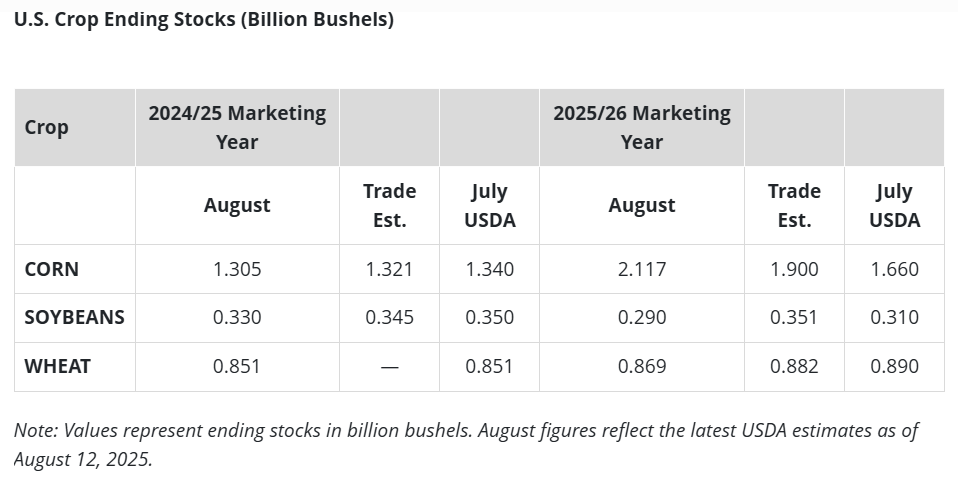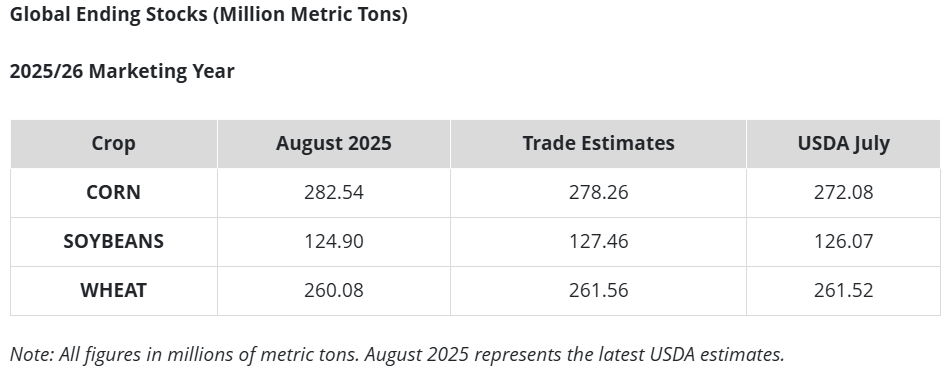Corn futures plunged to contract lows below $4 per bushel after USDA hiked its U.S. yield estimate to an all-time high at 188.8 bushels per acre and forecast a record crop at 16.74 billion bushels. Soybean futures rallied near three-week highs after USDA unexpectedly lowered its harvest forecast.
USDA’s updated yield estimate, in today’s Crop Production report, was up 4.3% from the agency’s previous forecast and blew past analysts' expectations for a number closer to 184.3 bpa. The updated harvest figure topped the average estimate by over 750 million bushels and would be up nearly 13% from last year’s crop.
With a huge crop in the pipeline, U.S. corn stockpiles at the end of the 2025-26 marketing year next summer may swell to 2.117 billion bushels, up 62% from 2024-25 and a seven-year high, based on USDA’s monthly Supply and Demand update, released separately today.
“Obviously, this is not bullish for corn in the short-run or the long-run,” said Tyler Schau, a partner at AgMarket.Net. “The USDA is confirming what a lot of analysts were estimating: that this corn crop is big. That said, U.S. corn was already the cheapest in the world. This will keep demand for U.S. exports strong and that should continue to keep a bid under the market.”
At the close of trading, December corn futures tumbled 13.25 cents at $3.9450 after hitting a contract low at $3.92. November soybeans rallied 21.5 cents to $10.3275, the contract’s highest close since July 18. September SRW wheat sank 10 cents to $5.05 after dipping to a contract low at $5.0325.
USDA’s corn and soybean yield production estimates were the first of the year based on surveys of U.S. farmers. About 14,900 producers were surveyed, primarily by phone, between July 25 and August 6 and asked about probable yields, USDA said. These producers will continue to be surveyed throughout the remainder of the growing season.
The following are summaries of today’s Crop Production and Supply and Demand reports:
Corn planted acres revised higher
The nation’s farmers are poised to reap their biggest corn harvest ever thanks to a sharp increase in planted acreage and favorable growing conditions in much of the Midwest over the spring and summer. The crop was largely seeded ahead of the typical pace and crop ratings have held near historically high levels amid abundant rains across the Corn Belt.
Corn plantings were substantially higher than USDA projected earlier this year. USDA hiked its corn plantings estimate 2.2% to 97.254 million acres, up 7.4% from 2024 and the highest since 2012.
Yields for some of the top corn states are expected to jump sharply over last year. Iowa’s average estimated statewide yield is seen at 222 bpa, up from 211 bpa in 2024, while Illinois is seen at 221 bpa, up from 217 bpa.
While supplies are increasing, corn demand is expected to continue at a record pace into next year. Estimated exports in the current crop year, which ends August 31, were raised 7 million bushels to 2.82 billion bushels. Exports during the upcoming 2025-26 crop year were boosted to a record 2.875 billion bushels, up 200 million bushels from a July forecast.
Ending stocks at the close of 2024-25 were cut 35 million bushels to 1.305 billion bushels, a four-year low. The estimated average U.S. farm price for corn was cut to $3.90 from $4.20.
The following summarizes key USDA corn and soybeans estimates:

Soybean planted acreage sharply lowered
By contrast, USDA’s soybean estimates were surprisingly bullish. U.S. soybean production was pegged at 4.292 billion bushels, down 1.7% from the 2024 and short of trade expectations at about 4.365 billion bushels.
The average U.S. yield estimate was boosted 2.1% to a record 53.6 bpa, higher than expected, but USDA also slashed planted area almost 3% to 80.93 million acres.
Soybean supplies at the end of 2025-26 were also reduced, reflecting expectations for a smaller crop and continued strong crushing demand. USDA pegged ending stocks at 290 million bushels, down 20 million bushels from a July estimate and down 40 million bushels from 2024-25.
“One of the big surprises in this report was the increase in acres on corn and decrease in soybeans,” Schau said. “We may debate about how accurate they are until we are blue in the face, but at the end of the day the numbers are what they are.”
For farmers, “the key takeaway is to always control what you can control,” Schau added. “Meaning, create a marketing plan that does not require the USDA or any private firm to estimate numbers that are in your favor.”
Bullish aspects of the soybean supply numbers were tempered by an outlook for weaker U.S. exports, with China continuing to stay out of the market for new-crop soybeans. USDA lowered its 2025-26 export forecast to 1.705 billion bushels, down 9.1% from 2024-25.
USDA held its average 2025-26 farm price estimate for soybeans at $10.10, up 10 cents from 2024-25.
Wheat numbers a mixed bag
USDA numbers were a mixed bag for U.S. wheat but the market remained under pressure amid ample global supplies, keeping futures prices near five-year lows.
Estimated production for all U.S. wheat in 2025-26 was lowered slightly to 1.927 billion bushels, about 7 million bushels above expectations. The U.S. winter wheat production was trimmed by 26 million bushels to 1.355 billion bushels, also slightly above expectations.
USDA raised 2025-26 exports by 25 million bushels to 875 million bushels, up almost 6% from 2024-25 and a five-year high. Ending stocks for 2025-26 were lowered 21 million bushels to 869 million bushels, still a six-year high.
The following is a summary of USDA’s latest U.S. and global ending stocks estimates:

